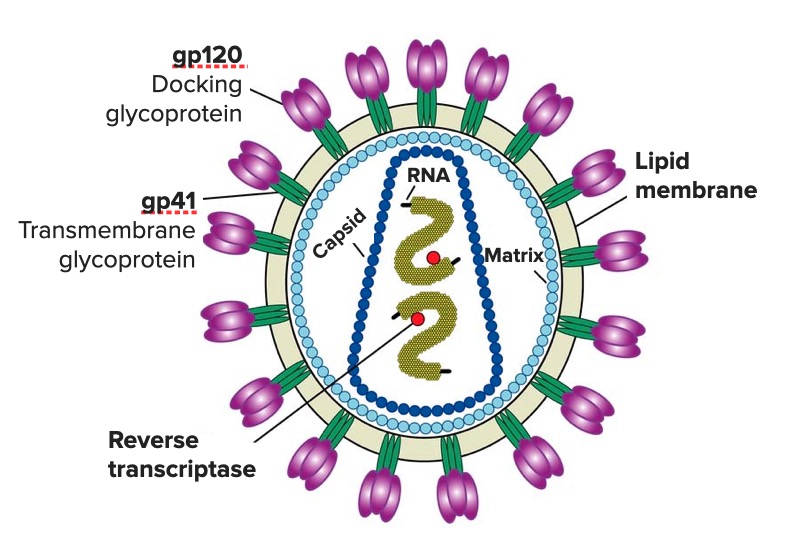Playlist
Show Playlist
Hide Playlist
Retroviruses
-
02-43 Retrovirus DLM.pdf
-
Download Lecture Overview
00:01 The retroviridae, viruses. 00:04 The retroviruses are going to be quite familiar to you because the principal one's the human immunodeficiency virus, HIV. 00:13 These are mid-sized, enveloped viruses, with a helical capsid. 00:18 And they have 2 copies of a linear, single-stranded, positive-sense RNA genome, along with transfer RNA. 00:25 In addition, these carry a reverse transcriptase, integrase, protease. 00:30 They carry all the machinery necessary to generate their own copy multiple times over You can see in the micrograph or the electron micrograph to the right, 2 circled forms of retrovirus. 00:42 These are HIV, and they have a very distinctive shape with a very organized capsular structure. 00:49 As mentioned, the medically relevant species we'll talk about in this session are human immunodeficiency virus, HIV, and something which is quite related, the to human T lymphotropic virus. 01:02 As you're getting a sense, both viruses will target lymphocytes in their action. 01:08 Looking a bit more closely at the retroviruses, and again, using HIV as the model, they carry very complex gene products to encode various elements and various proteins. 01:21 There's a gag protein which encodes nucleocapsid proteins, and you can see that identified in the middle. 01:28 You can see the Pol gene which encodes enzymes which are important for the regeneration of the RNA, DNA, and that would be your reverse transcriptase. 01:38 And then integrase, protease all responsible for various life cycles of the HIV as it replicates itself and buds off. 01:47 And then the env gene which encodes specific envelope glycoproteins, which are very important for the virus binding to its target site on the lymphocytes. 01:57 The challenge with HIV and you, I'm sure, have followed this in the medical news, as well as even the common news, is to try and create vaccines and even a way to address, by medication, the virus itself. 02:12 And it's a challenge because the virus is very complicated and thus, it creates multiple mutations. 02:18 It changes itself quite frequently So it's hard to identify a single specific target, either to create vaccine or to create a treatment. 02:29 So, the reverse transcriptase is one example of multiple mutations, but so, too, there are changes in the envelope and even the gag proteins, all of which change how the virus has tropism and binding strategies. 02:44 And as we just mentioned, drug resistance is a significant challenge, even under selective pressure, with the currently available antiretroviral therapy known as HAART, highly active antiretroviral therapy.
About the Lecture
The lecture Retroviruses by Sean Elliott, MD is from the course Viruses.
Included Quiz Questions
Which of the following genes present in the human immunodeficiency virus encodes enzymes like reverse transcriptase, protease, and integrase?
- Pol
- Gag
- Env
- Tat
- Rev
The specific shape of the capsid of the human immunodeficiency virus is...?
- ...helical.
- ...prolate.
- ...icosahedral.
- ...circular.
- ...dodecahedral.
Customer reviews
5,0 of 5 stars
| 5 Stars |
|
5 |
| 4 Stars |
|
0 |
| 3 Stars |
|
0 |
| 2 Stars |
|
0 |
| 1 Star |
|
0 |




